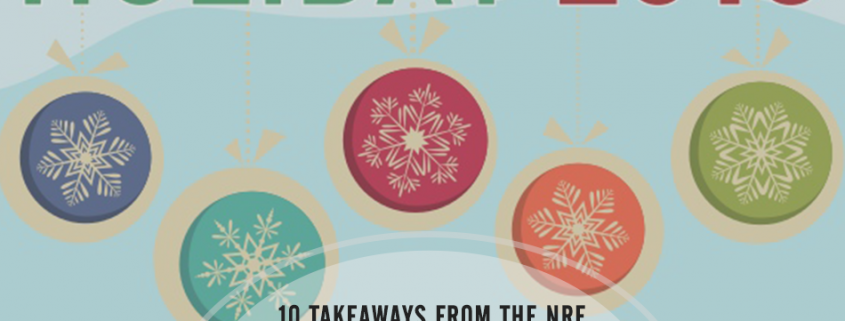10 Takeaways from NRF Holiday Shopping Forecast Slideshow
The most wonderful time of the year for retail sellers is right around the corner. Find out what’s in the National Retail Federation’s 2016 Holiday Shopping Forecast.
10 Things to Expect from Consumers During the 2016 Holiday Shopping Season
Each year the National Retail Federation’s holiday headquarters offers data retailers can use to help improve inventory selection, sales and offers, and consumer marketing, in order to grow holiday sales. Given that holiday sales could make up one quarter (or even more) of a retailer’s total annual sales, it’s important for them to get it right.
2016 Holiday Shopping Forecast Slideshow and Insights
2016 Holiday Shopping Forecast from National Retail Federation
1. Holiday sales are expected to grow.
The NRF holiday shopping forecast calls for a 3.6 percent increase in total sales, which are projected to exceed $655 billion. If it holds true, this will make 7 straight years of holiday sales increases and will be slightly above the 7-year average of 3.4 percent increases.
2. Nearly 700,000 seasonal positions will be added.
Although retailers are expected to add 690,000 positions during the holidays, that number is down from the 764,000 positions added in 2013 and slightly below the number added in 2014.
3. Eight industries depend most heavily on the 2016 holiday shopping season going well.
Eight industries derived 20 percent or more of their total annual sales from the holiday season. Of these, the jewelry industry is most dependent on healthy consumer spending, as the only industry that drew 27 percent – more than one quarter – of its total revenues during the holidays. Here are the ten industries that depend most on holiday sales:
- 4% – Jewelry
- 2% – Department stores
- 2% – Sporting goods, hobby, book and music stores
- 23% – Discount department stores
- 5% – Electronic shopping and mail order retailers
- 3% – Electronics and appliance stores
- 5% – Clothing stores
- 20% – Shoe stores
- 2% – Warehouse clubs and superstores
- 1% – Furniture and home furnishings stores
4. The individual shopper’s total spending won’t quite hit last year’s all-time-high.
Last year individuals spent an average of $952.58 in November-December (which includes gifts for others, non-gifts, food, decorations, flowers and greeting cards). This year that number is expected to be $935.58 per person, distributed as:
- $460.67 on gifts for family members (down slightly from last year)
- $104.57 on candy and food (down from last year)
- $76.83 on gifts for friends (nearly equal to last year)
- $54.75 on decorations (up slightly from last year)
- $27.34 on greeting cards and postage (down slightly from last year)
- $26.65 on gifts for others
- $24.75 on gifts for co-workers (equal to last year)
- $20.41 on flowers and potted plants (down slightly from last year)
5. Consumers aren’t just shopping for others.
Taking advantage of deep discounts, door buster sales and other special offers, consumers will spend about $140 on non-gift items, up 4.4 percent from last year.
6. Most people start shopping in November.
Even though you might have seen department stores breaking out holiday decorations and sale goods just as the back-to-school shopping season ended, it doesn’t necessarily follow that consumers are feeling the holiday spirit any earlier. More than 41 percent don’t start their holiday shopping until November, and over 15 percent even wait until December.
- 2% – Before September
- 5% – September
- 9% – October
- 4% – November
- 15% – First 2 weeks of December
- 3% – Last 2 weeks of December
7. Gift cards top the consumer’s wish list.
Six out of 10 consumers put gift cards at the top of their holiday wish list, above any other item. Female consumers are even more likely to want a gift card than men, 69 to 53 percent. Here’s how consumers rank their preferences for gifts in these ten categories:
- 61% – gift cards or gift certificates
- 54% – clothing or clothing accessories
- 40% – books, CDs, DVDs, videos, video games
- 32% – consumer electronics or computer-related accessories
- 23% – jewelry or precious metal accessories
- 23% – home décor or home-related furnishings
- 21% – personal care or beauty items
- 19% – sporting goods or leisure items
- 17% – home improvement items or tools
- 7% – other
8. Online shopping will nearly equal department store shopping this year.
A number that has been in the making for the past few years, nearly as many consumers will shop online as will shop in department stores during the 2016 holiday shopping season. This represents a nearly 7 percent year over year increase in the number of consumers who will shop online with online holiday sales expected to increase from 7 to 10 percent, going as high as $117 billion.
Given that the difference in the number of consumers who say they’ll shop online or at department stores amounts to one tenth of one percent, it’s also possible that more people will shop online than shop in department stores for the holidays. Here’s the list of where consumers plan to shop this year:
- 6% – department stores
- 5% – online
- 7% – discount stores
- 5% – grocery stores
- 6% – clothing or accessories stores
- 9% – electronics stores
- 7% – local small businesses
- 3% – crafts or fabric stores
- 15% – drug stores
- 5% – specialty stores
- 1% – outlet stores
- 8% – thrift or resale stores
- 9% – catalogs
9. What do holiday shoppers want?
It’s no surprise that nearly 3 out of 4 consumers say that it is sales and discounts that will bring them in the retailer’s door (or onto their online store). Nearly half of consumers (an all-time high) also said that free shipping would tip the scale in an online retailer’s favor. Here’s how consumers ranked these nine factors:
- 3% – sales or discounts
- 5% – quality of merchandise
- 2% – selection of merchandise
- 2% – free shipping or shipping promotions
- 9% – convenient location
- 1% – everyday low prices
- 3% – no hassle return policies
- 2% – easy-to-use website or mobile shopping site (highest number ever)
- 3% – helpful, knowledgeable customer service
10. We don’t know what we don’t know.
Last year, inclement weather negatively affected holiday shopping in some parts of the U.S., and could do so again. Likewise, bad winter weather can wreak havoc on shipping and transportation of goods to stores, between distribution centers and deliveries. Politics, economics, marketplace factors, safety concerns – any number of factors could ultimately change consumer shopping behavior or affect planned spending. The National Retail Federation plans to update their SlideShare presentation as new data is revealed leading up to and during the holiday season.
You might also like: 8 Apps That Simplify the E-commerce Experience for Holiday Shopping






